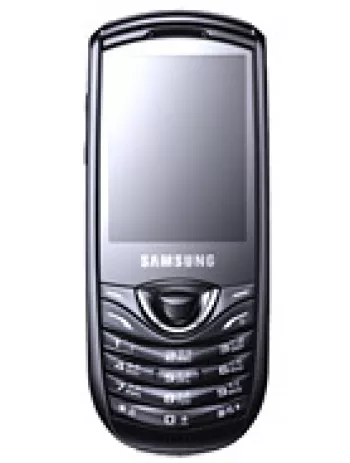
Overview of Samsung M3510 Beat b
The Samsung M3510 Beat b, released in 2009, represents a unique chapter in the evolution of mobile phones. During this era, feature phones dominated the market, offering basic functionalities paired with specialized features aimed at catering to specific consumer needs. The Samsung M3510 Beat b is no exception, with its music-centric design, slim profile, and essential telecommunication capabilities.
Design and Build
The device boasts a compact and sleek design, measuring 109 x 46 x 9.9 mm and weighing a mere 68 grams, making it highly portable and easy to carry. The ultra-slim profile enhances its aesthetic appeal and comfort in hand. The phone comes equipped with a Mini-SIM slot, reinforcing the standard of that time period. Users had color options of Black and White, giving some degree of personalization to suit individual tastes.
Display
The Samsung M3510 features a 2.0-inch TFT display, with a resolution of 240 x 320 pixels. Despite its small size and the era's technological limitations, the screen still showcases 16 million colors, delivering a vibrant and relatively sharp visual experience for viewing images and navigating the phone's UI. With a screen-to-body ratio of approximately 24.7%, its display is modest when compared to modern standards but satisfactory for its time.
Camera Capabilities
The phone's primary camera is a single 2 MP shooter, capable of capturing standard-resolution images and video. While it lacks advanced features seen in contemporary smartphones, it serves well for quick captures and basic photography needs. There is no front-facing camera, as selfies were not yet a widespread trend during its release.
Audio and Music Features
As a music-centric phone, the Samsung M3510 Beat b shines in its audio capabilities. It has a built-in loudspeaker and includes a standard 3.5 mm headphone jack, allowing for versatile playback options. The stereo FM radio with RDS and recording capabilities further expands its auditory services. Coupled with Bluetooth 2.0 and A2DP, music can be streamed wirelessly to compatible devices, offering flexibility to users who are constantly on the move.
Performance and Memory
Internally, the Samsung M3510 comes with 40MB of storage, which, by today's standards, is quite minimal. However, it supports a microSD card slot, which comes with a 1 GB card included, enabling storage of additional music files and essential data. It is equipped to manage basic telephony tasks and run standard applications without overloading its limited memory resources.
Network and Connectivity
The device operates on GSM technology, supporting bands GSM 900/1800/1900. It offers essential connectivity features through GPRS and EDGE (both class 10), allowing for basic internet connectivity and email use through its WAP 2.0/xHTML browser. While lacking modern WLAN capabilities, it excels in delivering the foundational web access expected from feature phones at the time.
Battery Life
Equipped with a removable 800 mAh Li-Ion battery, the Samsung M3510 Beat b provides ample power for its features. Users can enjoy up to 250 hours of standby time, up to 5 hours of talk time, and a notably extended music playback time of up to 19 hours and 30 minutes. This is especially appealing for users intending to utilize the phone primarily for music listening.
User Interface and Features
As part of its feature phone design, the Samsung M3510 Beat b offers a straightforward user interface. It supports multiple messaging formats, including SMS, MMS, Email, Push Email, and Instant Messaging. Additionally, users benefit from downloadable games and Java applications (MIDP 2.0), enhancing its versatility as an entertainment device. The inclusion of an accelerometer, albeit rare for feature phones, provides innovative interactive functions.
Pricing and Market Position
Upon release, the Samsung M3510 Beat b was priced at approximately 110 EUR, positioning it competitively within the market of feature phones. Its affordability, combined with focused music features, made it an attractive option for younger audiences and music enthusiasts seeking a reliable secondary device.
Conclusion
The Samsung M3510 Beat b offers a snapshot of a time when feature phones were the bridge between basic telephony and the budding smartphone revolution. With its music-oriented features, compact design, and essential communication tools, it met the needs of a niche audience looking for a dedicated music player with phone capabilities. Despite being discontinued, it remains a notable example of Samsung's innovation during the pre-smartphone era.
Main Features of Samsung M3510 Beat b
- Compact and lightweight design with dimensions of 109 x 46 x 9.9 mm and weight of 68 g.
- TFT display with 16M colors and a resolution of 240 x 320 pixels.
- Dedicated microSD card slot, 1 GB included, expandable storage option.
- 2 MP main camera with video recording capabilities.
- Audio features including a loudspeaker and 3.5mm jack.
- Bluetooth 2.0 with A2DP for wireless audio streaming.
- Stereo FM radio with RDS and recording feature.
- Accelerometer sensor for better gaming and application experiences.
- Extensive messaging options: SMS, MMS, Email, Push E-Mail, IM.
- Removable Li-Ion 800 mAh battery providing up to 5 hours of talk time and up to 19.5 hours of music playback.
- Available in classic colors: Black and White.
Disadvantages of Samsung M3510 Beat b
- Lacks 3G and 4G network support - only supports GSM technology.
- No WiFi connectivity is available.
- Limited internal memory of 40MB, although expandable via microSD.
- Low screen size of 2.0 inches, with a low screen-to-body ratio (~24.7%).
- No built-in GPS positioning feature.
- Primary camera is quite basic with only 2 MP resolution and lacks a flash.
- No dedicated selfie camera is available.
- Limited battery capacity of 800 mAh, though removable.
- Discontinued model, no longer available for purchase as new.


View Also
More Phones
All Rights Reserved +14266 Phones © Mobilawy 2025

























